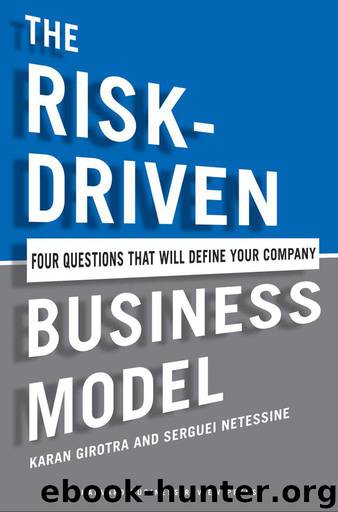The Risk-Driven Business Model: Four Questions That Will Define Your Company by Karan Girotra & Serguei Netessine

Author:Karan Girotra & Serguei Netessine
Language: eng
Format: mobi
Publisher: Harvard Business Review Press
Published: 2014-06-09T16:00:00+00:00
CHAPTER 6
The Why Strategy
In an ideal world, each actor in an organization would set aside self-interest and collaborate for the good of the system as a whole, agreeing to share the profits in a reasonable fashion. In theory, it is possible for an organization’s culture to be shaped in such a way as to achieve this ideal situation. But when organizations grow larger and more complex, internal fiefdoms and rivalries emerge, making it difficult for culture alone to ensure this collaborative ideal.
That is because the rewards and incentives that determine compensation are designed to motivate types of behavior that advantage the work of each functional area, department, or business unit, and those motivators typically vary from one corner of the business to another. In essence, they define why people do what they do and, often, the way they do it. While rewards and incentives can do a fine job in the context for which they were designed, their very effectiveness will often undermine collaborative work by causing participants to behave in self-interested ways.
This problem can be even more troublesome when multiple firms must work together toward a common objective. The incentives that motivate different organizations pull against each other, and the value chain as a whole suffers. Within a single firm, managers may possess enough leverage to intervene and force the desired give-and-take. But between separate firms, intervention is typically more complicated, marking the difference between working within one tribe and working with two or more whose incentives are not aligned. (See the sidebar, “Why We Do What We Do.”)
The purpose of this chapter is to show you how to resolve incentive misalignments by making changes to your business model. We recommend three approaches. The first is to change the revenue and profit stream in the transactions between different organizations. You might accomplish this by changing contractual arrangements between parties in your value chain. For example, a traditional contract might involve paying a supplier a fixed amount for provided goods, whereas an innovative contract would tie payment to the quality of the end result (profits and revenues or performance). The second approach is to synchronize the differing time horizons imposed by the parties’ respective business models in order to repair misaligned incentives. For example, one organization might care only about a single transaction’s immediate gains or losses, while the other is focused on building longer-term value. If both parties commit to an open-ended relationship—one that will encompass many transactions into the foreseeable future—each develops a mutual interest in the other’s sustained long-term success. By syncing their time horizons, both organizations will work for the common good. The third approach covers situations in which the uncertainty is so high that it is not possible to write contracts that cover all contingencies or to commit to engaging with the other party for the foreseeable future. In such situations, the best (and often only) solution may be to pursue a strategy of vertical integration.
. . .
Why We Do What We Do
You may have observed firsthand that incentives can work in unpredictable ways.
Download
This site does not store any files on its server. We only index and link to content provided by other sites. Please contact the content providers to delete copyright contents if any and email us, we'll remove relevant links or contents immediately.
Bad Blood by John Carreyrou(6514)
Rich Dad Poor Dad by Robert T. Kiyosaki(6349)
Principles: Life and Work by Ray Dalio(6164)
Playing to Win_ How Strategy Really Works by A.G. Lafley & Roger L. Martin(5839)
Management Strategies for the Cloud Revolution: How Cloud Computing Is Transforming Business and Why You Can't Afford to Be Left Behind by Charles Babcock(4507)
The Confidence Code by Katty Kay(4172)
Thinking in Bets by Annie Duke(4137)
American Kingpin by Nick Bilton(3734)
Delivering Happiness by Tony Hsieh(3351)
Project Animal Farm: An Accidental Journey into the Secret World of Farming and the Truth About Our Food by Sonia Faruqi(3160)
The Power of Habit by Charles Duhigg(3040)
Brotopia by Emily Chang(2982)
The Tyranny of Metrics by Jerry Z. Muller(2973)
Mastering Bitcoin: Programming the Open Blockchain by Andreas M. Antonopoulos(2964)
The Marketing Plan Handbook: Develop Big-Picture Marketing Plans for Pennies on the Dollar by Robert W. Bly(2937)
I Live in the Future & Here's How It Works by Nick Bilton(2917)
The Content Trap by Bharat Anand(2849)
Applied Empathy by Michael Ventura(2825)
Building a StoryBrand by Donald Miller(2824)
